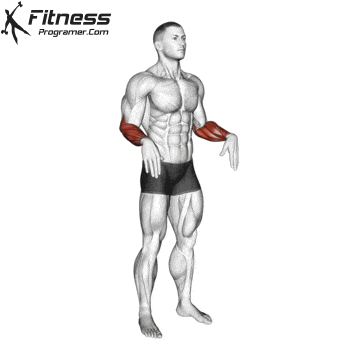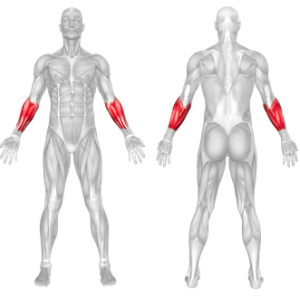Overview
Wrist rotations are a circular movement of the wrist joint, usually performed without resistance. It’s a simple, low-impact mobility exercise used to maintain or improve the range of motion in the wrist joint. It is commonly included in warm-ups for weight training, calisthenics routines, or rehabilitation protocols to prevent overuse injuries and support healthy movement patterns.
How to Perform Wrist Rotations

Stand or sit upright, keeping your shoulders relaxed.
Extend both arms forward, elbows slightly bent or locked depending on your preference.
Make loose fists or open palms, then rotate your wrists in slow, controlled circles.
Perform 10–15 rotations clockwise, then reverse the direction for 10–15 counterclockwise reps.
Breathe naturally and avoid moving your elbows or shoulders during the motion.
Tips for Proper Form
Move only the wrists, not the forearms or shoulders.
Keep the motion smooth, avoiding jerky or rushed circles.
Focus on full circular range, not just flicking back and forth.
Relax your fingers to avoid unnecessary tension.
Include in warm-ups before strength or hand-based exercises.
Common Mistakes
Moving the elbows or arms, instead of isolating the wrists.
Rotating too fast, which reduces the effectiveness of joint priming.
Forgetting both directions, limiting mobility and muscle balance.
Tensing the forearms, creating fatigue or discomfort.
Neglecting to include in warm-ups, especially before wrist-loading exercises.
Benefits of the Wrist Rotations
Increases Joint Mobility: Promotes better range of motion in the wrist, preparing it for movement and load.
Reduces Risk of Injury: Prepares connective tissues and muscles for training or repetitive activity.
Improves Blood Flow: Enhances circulation in the hands and wrists, especially during long periods of inactivity.
Aids in Rehabilitation: Supports joint recovery and flexibility following sprains or strain-related injuries.
Improves Movement Efficiency: Helps in exercises requiring wrist extension or flexion like push-ups or front squats.
Supports Daily Activity: Beneficial for artists, writers, lifters, and anyone who uses their hands repetitively.
Prepares for Strength Training: Ideal for warming up before exercises like cleans, handstands, or overhead pressing.
How to Incorporate Into Your Routine
- For Warm-Ups: Perform 2 sets of 10–15 reps in each direction before upper body or full-body training.
- For Mobility Training: Include wrist circles in a joint-specific mobility session 2–3 times per week.
- For Rehabilitation: Use gentle, low-volume reps as prescribed by a physiotherapist.
- For Functional Training: Pair with grip work or hand-balancing drills for wrist prep.
- For Desk Workers: Perform 2–3 times daily to combat wrist stiffness and improve circulation.
- For General Fitness: Incorporate during dynamic warm-ups or cooldowns to promote long-term joint health.
Muscles Worked

Frequently Asked Questions
Are wrist rotations good before lifting?
Yes. They improve mobility and prepare the joint for weight-bearing movements.
How often should I do wrist rotations?
Daily is ideal, especially if you train frequently or work at a computer.
Can wrist rotations prevent carpal tunnel?
They may help reduce tension and improve circulation, but they don’t replace medical treatment.
Should I use weights or bands?
No. This is a bodyweight mobility drill. Keep the movement unloaded and controlled.
Is it normal to feel clicking?
Mild clicking can be normal if it’s painless. Stop if you feel discomfort or instability.
